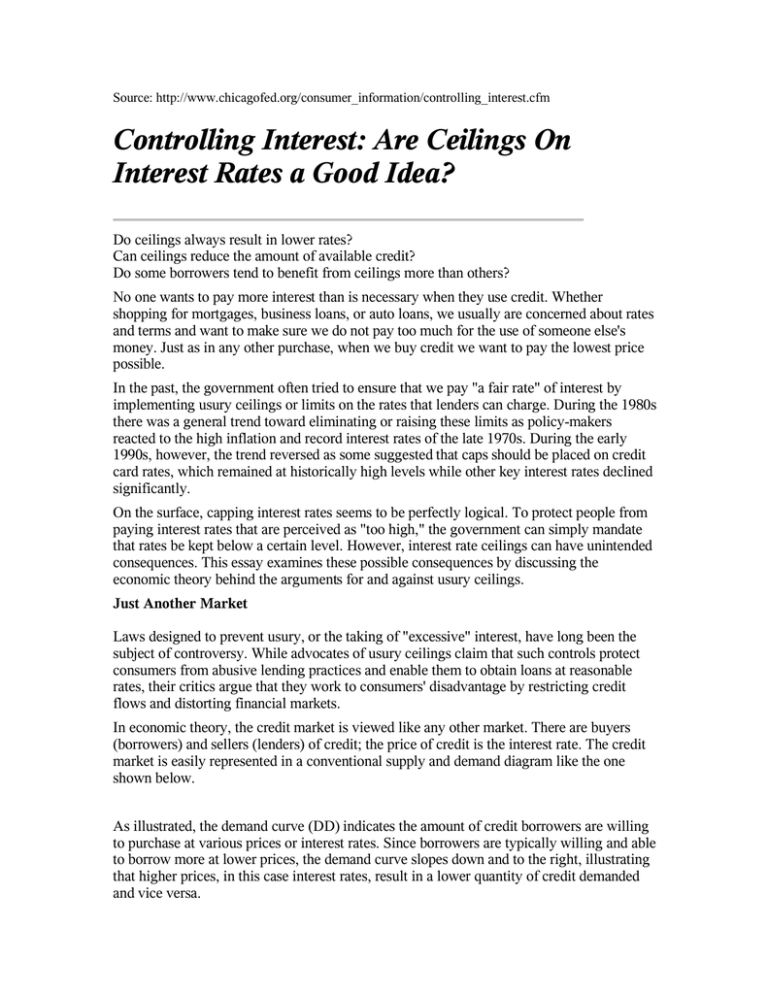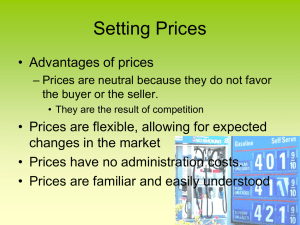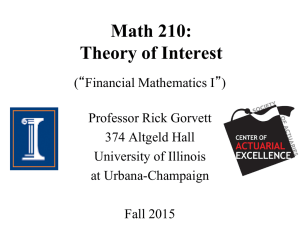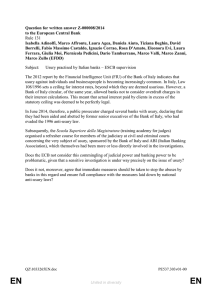Controlling Interest: Are Ceilings On Interest Rates a Good Idea?
advertisement

Source: http://www.chicagofed.org/consumer_information/controlling_interest.cfm Controlling Interest: Are Ceilings On Interest Rates a Good Idea? Do ceilings always result in lower rates? Can ceilings reduce the amount of available credit? Do some borrowers tend to benefit from ceilings more than others? No one wants to pay more interest than is necessary when they use credit. Whether shopping for mortgages, business loans, or auto loans, we usually are concerned about rates and terms and want to make sure we do not pay too much for the use of someone else's money. Just as in any other purchase, when we buy credit we want to pay the lowest price possible. In the past, the government often tried to ensure that we pay "a fair rate" of interest by implementing usury ceilings or limits on the rates that lenders can charge. During the 1980s there was a general trend toward eliminating or raising these limits as policy-makers reacted to the high inflation and record interest rates of the late 1970s. During the early 1990s, however, the trend reversed as some suggested that caps should be placed on credit card rates, which remained at historically high levels while other key interest rates declined significantly. On the surface, capping interest rates seems to be perfectly logical. To protect people from paying interest rates that are perceived as "too high," the government can simply mandate that rates be kept below a certain level. However, interest rate ceilings can have unintended consequences. This essay examines these possible consequences by discussing the economic theory behind the arguments for and against usury ceilings. Just Another Market Laws designed to prevent usury, or the taking of "excessive" interest, have long been the subject of controversy. While advocates of usury ceilings claim that such controls protect consumers from abusive lending practices and enable them to obtain loans at reasonable rates, their critics argue that they work to consumers' disadvantage by restricting credit flows and distorting financial markets. In economic theory, the credit market is viewed like any other market. There are buyers (borrowers) and sellers (lenders) of credit; the price of credit is the interest rate. The credit market is easily represented in a conventional supply and demand diagram like the one shown below. As illustrated, the demand curve (DD) indicates the amount of credit borrowers are willing to purchase at various prices or interest rates. Since borrowers are typically willing and able to borrow more at lower prices, the demand curve slopes down and to the right, illustrating that higher prices, in this case interest rates, result in a lower quantity of credit demanded and vice versa. The supply curve (SS) reflects the amount of credit lenders are willing to provide at various rates. The curve slopes upward because lenders costs, including the cost of funds, increase as more credit is supplied. At the same time, higher rates (the price of credit) offer an incentive for savers to provide more funds for lending. That is, lenders are able and willing to offer more credit at higher rates of interest than at lower rates. In a competitive market, as borrowers increase their demands for a limited supply of credit, they compete with one another, thus "bidding up" prices. But as prices (rates) rise, lenders will want to offer more credit, thereby increasing supply and helping to satisfy demand. In addition, as prices increase, demand will generally decrease. This "bidding" process continues until borrowers and lenders eventually establish an equilibrium price that balances the supply of and demand for credit. This price is called the market rate of interest, which is represented on the second diagram as the point where the demand curve and supply curve intersect. Lower Rates Can Be Bad - Sometimes Usury laws establish a legal maximum interest rate (or price) that lenders may charge for a loan or extension of credit. These laws are, in effect, a form of price control. When a usury law is introduced, it may have no impact on the credit market or it may alter the way in which price and quantity are determined. Exactly what happens depends on where the usury ceiling is relative to the market rate. When the legal ceiling is above the market rate of interest, the law has no effect at all. The market forces of supply and demand are not bound by the usury ceiling, and the equilibrium price and quantity of credit are unchanged. However, when the legal ceiling is below the market rate of interest, the regulation can affect the market outcome. Such a usury ceiling is said to be binding or effective. A binding ceiling obviously alters the price of credit — the ceiling rate becomes the rate of interest charged. But, establishing a lower-than-market interest rate by means of a usury ceiling will also bring about a decrease in the quantity of credit supplied. Given lenders costs, the amount of credit they will provide when the interest rate is held down is limited. Like any other business, if a lender does not recoup its costs and earn an adequate return on its resources, it will put those resources to work elsewhere. Since the amount of credit offered will not satisfy all those who are willing to borrow at the ceiling price, excess demand is created, giving rise to a situation in which the reduced amount of credit must be rationed among borrowers by some means other than price. The diagram left illustrates a binding ceiling. The usury ceiling intersects supply and demand below the equilibrium price, indicating that the quantity demanded exceeds the quantity supplied at the legal maximum rate or price. The gap between the supply and demand curves represents a "credit crunch," in which credit is not available despite the fact that there is demand for it. Who Gets Hurt and Who Gets Credit? Many of the strategies lenders are likely to follow in a "credit crunch," such as setting rigid loan terms, screening borrowers more rigorously, or increasing non-interest fees and charges, tend to concentrate the impact of usury ceilings on certain borrowers. For example, imposing more stringent loan terms such as shorter maturities and higher minimum loan size reallocates credit toward those who are able to afford larger down payments or larger monthly payments, generally those with higher incomes. Basing lending decisions heavily on individual characteristics, such as borrowing history or income, without the flexibility of adding risk premiums, can ration credit away from new or high-risk consumers who might be willing to pay higher-thanceiling rates. Finally, adding non-interest charges (such as higher fees) eliminates from the market those for whom these extra costs are too great. By encouraging these lending practices, usury ceilings may fail to give consumers the protection and benefits that they were intended to provide. That is, usury laws may actually reduce the amount of credit that is available to low income or inexperienced borrowers. Low-priced credit is not useful to those who cannot meet the requirements for obtaining it. Thus, when lenders ration credit by some means other than price, first-time borrowers, small borrowers, low-income and high-risk borrowers are likely to find it more difficult to obtain credit. The most creditworthy borrowers, on the other hand, may obtain more credit than they would have at normal market interest rates. Furthermore, when lenders institute non-interest charges such as fees to compensate for interest rate ceilings, they effectively raise the cost of credit for all successful borrowers. Therefore, while a ceiling may reduce the explicit price of credit (interest rate), it may not result in lower overall costs of borrowing even for those able to obtain loans. Additionally, non-interest charges make it more complicated for customers to comprehend the total cost of borrowing and more difficult to make well-informed credit decisions. While these lending practices and their undesirable consequences may exist in the absence of interest rate ceilings, several studies on the effects of usury ceilings have established that loan terms do become less favorable to borrowers when usury ceilings become more restrictive. Increased Competition and Consumer Responsibility A common argument in favor of usury laws is that without them, borrowers would be forced to pay exorbitant interest rates, or at least rates that are unreasonable in relation to the cost of supplying credit. According to economic theory, a competitive market is sufficient to prevent lenders from exercising power over pricing or earning more than a normal return. The price established in a competitive market reflects suppliers' costs of providing the given amount of that good. To be sure, removing a binding usury ceiling will result in higher interest rates. However, if credit markets are competitive, the resulting market rate of interest will not exceed lenders costs (including a fair return) of supplying credit. It is when competition is absent that consumers may face unreasonable interest rates. Thus, the consequences of not having usury ceilings depend importantly on the competitiveness of credit markets. Indeed, the absence of competition is the only reason for imposing a usury ceiling that can be justified by economic theory. Some of the responsibility for ensuring a competitive marketplace must be placed on borrowers themselves, since knowledgeable, informed borrowers help to foster competition in credit markets. When consumers do not know or cannot compare rates being charged by various lenders, each lender has more freedom to charge any rate — fair or unfair. A high level of borrower awareness can create a natural protection from unreasonable interest rates, in lieu of the external constraint of a usury ceiling.1 Economic theory suggests that interest rates are best determined by the marketplace rather than by legislative mandate. In the case of credit cards, however, some felt in the early 1990s that the market was not working as it should. Although most interest rates on consumer and business loans decreased significantly, credit card rates remained close to their highs of the early 1980s, seemingly impervious to market forces. Credit Cards Are No Different The credit cards that seemed to attract the most attention were the bank-issued "universal" cards such as Visa and Mastercard. These cards are called "universal" because of their wide acceptance at all types of establishments in contrast to retailer-issued cards and travel and entertainment cards. However, in the late 1980s and early 1990s, the distinctions were starting to blur as bank credit cards faced competition from new players, such as Sears, AT&T, and GM. Prior to the 1970s, there were only a few bank credit cards in existence. Most were tied to a specific bank network and lacked the "universal" aspect we take for granted today. The rapid expansion of Bank of America's program (today's Visa) and the Interbank group's program (MasterCard) in the early 1970s established the foundation for today's industry. From their earliest days, both card systems realized that a wide customer base would be highly desirable. Because of the nature of the service being extended, with issuing banks receiving only a very small percentage of each purchase amount charged, the best way to cover costs would be through a huge volume of customers and transactions. But widening the customer base brought more and more people into the credit pool who otherwise would not have qualified for cards. This increased risks to the banks and necessitated a higher interest rate on unpaid balances. The inflation of the late 1970s and early 1980s also had an effect. Generally, any loan that is extended to a consumer is paid back with dollars that are earned in the future. Because of this, both borrowers and lenders include expected inflation in setting the interest rate.2 This is done so that the lender or provider of the funds does not lose purchasing power as a result of making the loan. During the late 1970s and early 1980s, as inflation rates reached into the teens, the usury ceilings established in many states became binding. As inflation rates surpassed the legal maximum interest rates in many of these states, a few banks chose to get out of the credit card business. Others relocated to those states with higher usury ceilings or no ceilings at all. But as rates rose, another important phenomenon became apparent: consumers use of credit cards proved to be relatively inelastic — i.e., demand did not appear to decline as prices (interest rates) rose. Inelastic demand is illustrated in the diagram left in which the quantity of credit demanded changes by relatively small amounts as represented by the nearly vertical slope DD compared to the size of the price (interest rate) change. During the late 1970s and early 1980s, even though the nominal rates on credit cards rose, almost the same percentage of customers were carrying balances. In essence, there was little or no change in the demand for credit. Additionally, the dollar amount of the average balance being carried forward and financed from month to month had actually almost doubled. Thus, credit card users proved to be relatively slow in responding to changes in the marketplace, which were reflected in higher credit costs in the 1980s. With seemingly inelastic demand for credit, higher prices did not affect the amount of credit demanded as much as expected. What Caused the Inelasticity As discussed previously, every transaction has a seller and a purchaser, a supply side and a demand side. When credit is used, supply comes from the lender. Sellers want prices to exceed their costs of production, which for credit card transactions includes the costs banks must pay to secure funds to lend. There are additional overhead and transaction costs as well. But, in the simplest textbook treatment, the cost of funds to banks is estimated as the rate they are paying depositors or to borrow funds in the open market (usually estimated at the Treasury bill rate or the federal funds rate). The risk factor to the bank also affects the supply side. The fact that the loan represented by cards is unsecured (not backed by any collateral) makes the loan risky. Unlike mortgages and auto loans, the bank retains no lien against the property purchased. When there is no threat of repossession, the loan is generally believed to be at greater risk of default and loss. Because of this, a riskier loan demands higher interest rates. Therefore, one would expect an unsecured credit card loan to have a higher rate than a similar secured loan. Nevertheless, rates for credit cards should change in line with the general level of interest rates, even with a higher risk premium. Interestingly, most statistics indicate that the level of default for credit cards has tended to fluctuate within a fairly narrow range over time. Therefore, it appears there is little on the supply side of the equation to explain why credit card rates stayed level while other rates fell. There are a number of factors on the demand side which may explain the lack of elasticity for credit card demand during the 1980s. One interesting factor was the apparent "brand loyalty" of credit card customers during the period. This was particularly interesting because studies indicate that Americans show varying levels of brand loyalty to many products that they use. Credit cards would seem to be an odd item to invoke brand loyalty, but surveys have shown that only recently have large numbers of consumers begun to cancel the first credit card they received (often very expensive) in favor of those with a lower price (interest rate and/or annual fee). This "brand loyalty" may reflect, in part, how aggressively different institutions pursued customers. Those financial institutions that advertised heavily for new customers often had higher rates and less restrictive credit qualifications. Institutions offering lower rates and with more restrictive qualifications often were not as aggressive in seeking new cardholders. A related aspect of brand loyalty may be an affinity for cards issued by the "big name" banks. In general, the credit itself is no different whether offered by a large money-center bank or a small town independent bank, but consumers may have the perception that having a card issued by a large bank is an indication of creditworthiness. There also appears to have been a perception among consumers that obtaining a new card would not result in sufficient savings. This would be true if the consumer is in that portion (approximately one third) that pays the balance due, in full, each month. Under those circumstances, and if the card carries no annual fee, why worry about the interest rate? Even some of those who do carry a balance may not worry about the interest rate. Several studies have noted that more consumers see themselves as convenience borrowers (charging and paying off the entire balance monthly) than really exhibit such behavior; one study showed almost twice as many. Thus some consumers may not be concerned about interest rates even when they incur interest charges. How Does One Define Competition? Thus, there are several alternative explanations for the "non-competitiveness" in credit card rates ranging from brand loyalty to consumers' self-perception. But, we need to examine competition itself. Many people think of competition purely in terms of price, with one supplier lowering price to gain a market advantage, and subsequently forcing other suppliers to do likewise or lose market share. But another method of competing is to improve the quality of the product: that is, to keep the price constant but to provide more to the consumer. If we follow this line of reasoning, it is possible that credit cards are more competitive than commonly believed. Early on, credit card issuers saw quality as a way to provide more service to the customer without a substantial increase in costs. Among features that were rapidly introduced as technology improved were cash advances, which allowed customers to borrow cash without going through a formal loan process — in essence, a personal credit line. The 1980s also saw a proliferation of services attached to credit cards such as "buyer protection," which allowed for free replacement should an item purchased with the card be defective or stolen; random refunds of credit card purchases; and cash bonuses or other rebates on purchases of select products based on total purchases made with the card. These services have added to the perceived quality of the product, and all of them involve some cost to the supplier. In cases in which these costs were not charged directly to the customer, institutions chose to compete by improving quality as well as by lowering price. Evolution in the '90s Why, then, did credit card rates appear to remain high in the early 1990s rather than return to the levels of the early 1970s? Part of the answer lies in the costs that are inherent in providing credit cards, such as the high risk of unsecured loans. But perhaps a more important factor was the credit card market itself. As we've seen, demand for credit cards was relatively inelastic, with consumers less responsive to interest rates than might have been expected. On the supply side, ten issuing institutions accounted for more than half of the cards in the United States at the end of the 1980s. Although it would be wrong to say that the market did not work, it is appropriate to ask whether a market dominated by a relatively small number of suppliers responding to inelastic demand by buyers can be considered truly competitive. However, that situation began to change in the early 1990s. Consumers have become more aware of credit card terms and rates and more willing to search for the best deal, matching services to their needs. And, importantly, a host of new competitors have entered the card field, greatly intensifying competition in terms of both service and price. The "high" prices, whether actual or perceived, attracted new sellers to the market. In short, the market worked the way it usually has in the past, fostering increased competition and more selection for consumers. As competition continues to increase within the credit card market, consumers will have more choices. As consumers take advantage of their additional options, the market will be better able to allocate credit via various forms of competition, including price and service. There is something to be gained by understanding that, despite their stated intentions to the contrary, consumers are likely to run a balance and pay interest. Likewise, services and perks that are never used have no value and do add costs. Consumers need to match the card to their use and choose accordingly. As was stated earlier, a high level of borrower awareness can create a natural protection from unreasonable interest rates, in lieu of the external constraint of a usury ceiling. With increased awareness, the "invisible hand" of the marketplace can help to ensure that the credit card market meets the needs of borrowers and lenders alike. Information on Credit Card Rates The Board of Governors of the Federal Reserve System publishes extensive information on credit cards in its on-line publication Shop: The Card You Pick Can Save You Money. Information provided includes interest rates, annual fees (if any), grace periods, geographic limitations, and other information pertinent to making an informed consumer choice. Notes 1 In an effort to enhance the ability of consumers to compare interest rate charges and, therefore, to discourage unfair lending practices, Congress enacted the Truth in Lending Act in 1968. Unlike usury laws, Truth in Lending does not set interest rate limits. Rather, it requires creditors to provide clear and consistent information about loan terms so that consumers can easily "shop" for the best price and avoid charges that are out of line. 2 See Points of Interest, (PDF,7.74MB) published by the Federal Reserve Bank of Chicago, for more information on how inflation is calculated into interest rates.




